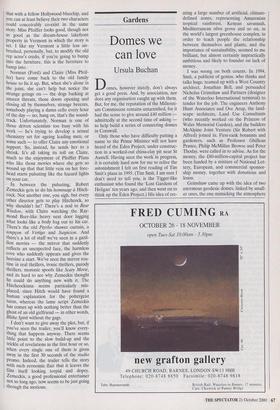Gardens
Domes we can love
Ursula Buchan
Domes, however stately, don't always get a good press. And, by association, nor does any organisation caught up with them. But, for me, the reputation of the Millenni- um Commission remains untarnished, for it had the sense to give around £40 million admittedly at the second time of asking to help build a series of connecting domes in Cornwall.
Only those who have difficulty putting a name to the Prime Minister will not have heard of the Eden Project, under construc- tion in a worked-out china-clay pit near St Austell. Having seen the work in progress, it is certainly hard now for me to relive the astonishment I felt on first reading of Tim Smit's plans in 1995. (Tim Smit, I am sure I don't need to tell you, is the Tigger-like enthusiast who found the 'Lost Gardens of Heligan' ten years ago, and then went on to think up the Eden Project.) His idea of cre- ating a large number of artificial, climate- defined zones, representing Amazonian tropical rainforest, Kenyan savannah, Mediterranean olive grove and so on, in the world's largest greenhouse complex, in order to teach people the relationship between themselves and plants, and the importance of sustainahility, seemed to me brilliant, but almost certainly impractically ambitious and likely to founder on lack of money.
I was wrong on both counts. In 1994, Smit, a publicist of genius, who thinks and talks huge, teamed up with a West Country architect, Jonathan Bell, and persuaded Nicholas Grimshaw and Partners (designer of the Waterloo International terminal) to tender for the job. The engineers Anthony Hunt Associates and Ove Arup, the land- scape architects, Land Use Consultants (who recently worked on the Princess of Wales Memorial Garden), and the builders McAlpine Joint Venture (Sir Robert with Alfred) joined in. First-rank botanists and gardeners, such as Professor Ghillean Prance, Philip McMillan Browse and Peter Thoday, were called in to advise. As for the money, the £80-million-capital project has been funded by a mixture of National Lot- tery, European, and commercial sponsor- ship money, together with donations and loans.
Grimshaw came up with the idea of two enormous geodesic domes, linked by small- er ones, the one mimicking the atmosphere in the humid tropics, the other the warm temperate zones. These are called covered `biomes', a term usually reserved for an eco-system like a tundra or steppe. From a distance these conservatories look like giant bubbles, captured in chicken-wire. The third 'biome' is uncovered, and is a series of crescent-shaped terraces for show- ing off the flora of Cornwall, together with that of other temperate regions. Bodelva Pit is a 15-hectare, 50-metre deep, south- facing bowl, plainly suited, once filled with soil, to growing a range of tenderish plants. There is also a 2,000-seater amphitheatre for open-air concerts and events.
The Eden Project is a feat of design and engineering which out-domes the Dome, and at a tenth of the price: the steel biomes, one of which is 50 metres tall and 110 metres wide at one point, have no internal support and are 'glazed' with hexagonal panes, made of layers of ETFE (ethyltetraflouroethylene), a transparent foil which is lighter and safer than glass and has a lifespan of 25 years. Because it is anti-static, it is self-cleaning apparently. The bowl is below water-table level so the drainage system has to be sophisticated; the ground water is filtered through mat- ting so that it can be recycled. Nor must the gardeners be forgotten: many of the plants, including a 15-metre high Kapok tree, have been grown at the Project's nurs- ery nearby. Early October saw the first plantings in the tropical 'biome'.
The Visitor Centre was built early on, so that people could see The Big Build' before the site opens fully in Easter 2001. I took my family there this summer. They were captivated, which is no easy feat where matters horticultural are concerned. We even went along with donning fluores- cent jackets and (completely pointless) hard hats, sitting in a kind of open train, lis- tening to a tape of Tim Smit telling us what we were seeing. We never got very near the site, but we felt somehow involved. We watched as the 'sky monkeys' put ETFE hexagons in place, then went to the Visitor Centre, to listen to more right-on right thinking and look at a number of clever and amusing interpretative exhibitions.
Apart from the balmy climate, and its proximity to Heligan, the great advantage of Bodelva Pit is that it is in a 5B zone, entitled to lashings of European Regional Development Fund money. It needs it. This is not the relatively prosperous, tourist-ori- entated Cornwall of Padstow and Polruan. Except that the slag heaps are white, not black, the nearby pit villages could be in South Yorkshire. It is interesting that the project got underway when Restormel Bor- ough Council gave a £25,000 donation, putting its faith in the Eden Project as employer and visitor draw, predicted to attract 750,000 people a year.
This is a venture, therefore, committed to industrial regeneration, international sci- entific research, sustainability, conserva- tion, education, arts and entertainment. If it does not collapse under the weight of its diverse objectives, who knows but the Eden Project might just become the Eighth Won- der of the World. Their words, not mine.
For more information: www.edenproject.com


























































































 Previous page
Previous page